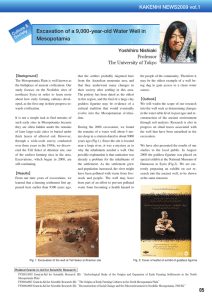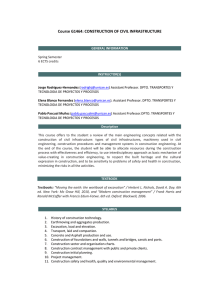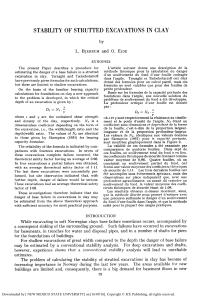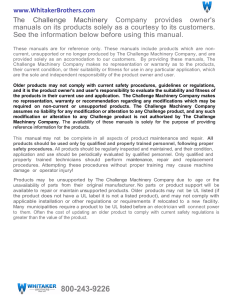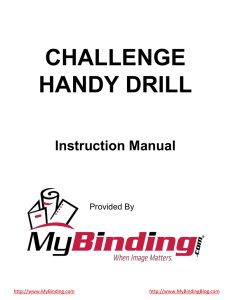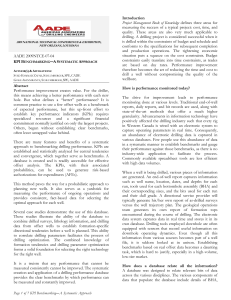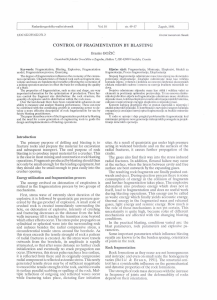(73.8K PDF) - Vermeer Corporation
Anuncio
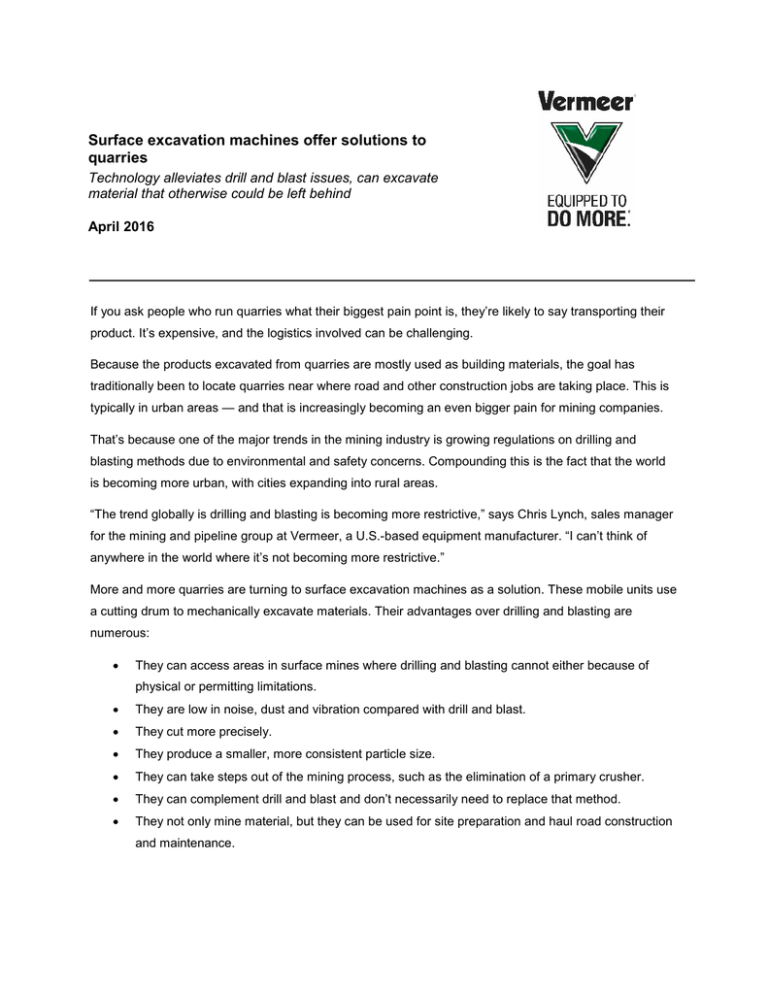
Surface excavation machines offer solutions to quarries Technology alleviates drill and blast issues, can excavate material that otherwise could be left behind April 2016 If you ask people who run quarries what their biggest pain point is, they’re likely to say transporting their product. It’s expensive, and the logistics involved can be challenging. Because the products excavated from quarries are mostly used as building materials, the goal has traditionally been to locate quarries near where road and other construction jobs are taking place. This is typically in urban areas — and that is increasingly becoming an even bigger pain for mining companies. That’s because one of the major trends in the mining industry is growing regulations on drilling and blasting methods due to environmental and safety concerns. Compounding this is the fact that the world is becoming more urban, with cities expanding into rural areas. “The trend globally is drilling and blasting is becoming more restrictive,” says Chris Lynch, sales manager for the mining and pipeline group at Vermeer, a U.S.-based equipment manufacturer. “I can’t think of anywhere in the world where it’s not becoming more restrictive.” More and more quarries are turning to surface excavation machines as a solution. These mobile units use a cutting drum to mechanically excavate materials. Their advantages over drilling and blasting are numerous: • They can access areas in surface mines where drilling and blasting cannot either because of physical or permitting limitations. • They are low in noise, dust and vibration compared with drill and blast. • They cut more precisely. • They produce a smaller, more consistent particle size. • They can take steps out of the mining process, such as the elimination of a primary crusher. • They can complement drill and blast and don’t necessarily need to replace that method. • They not only mine material, but they can be used for site preparation and haul road construction and maintenance. Lynch and Patrick Robinson, senior commercialization manager for mining at Vermeer, have seen these benefits in action. There’s a customer using a Terrain Leveler® surface excavation machine (SEM) from Vermeer who has chosen not to use a primary crusher because the Terrain Leveler SEM can consistently produce a 6-inch minus particle size. Another customer is a South American company that still has a million tons of mineable product, but it can no longer drill and blast because of nearby pipelines, powerlines and roads. “The surface excavation machine is getting that last remaining bit of aggregate,” Robinson says. “The site is already permitted, but if not for the surface excavation machine, it would probably be abandoned because drill and blast is no longer an option.” HOW IT WORKS Awareness of surface excavation machines is growing, but an explanation of the technology is still helpful. Machines vary by manufacturer, but generally, as the unit moves on tracks, its cutting drum rotates and the teeth on the drum cut the material into a consistent-sized product. An operator can control product size by adjusting the depth of the cut and the speed of the machine. To give an example, the Vermeer T1255 Terrain Leveler® surface excavation machine has a 600horsepower (447 kW) engine and can cut a swath up to 27 inches (68.6 cm) deep and 12 feet (3.7 m) wide in a single pass. It can be equipped with an optional GPS for precision cutting, allowing an operator to use the full length of the drum and minimize the overlap with each pass. Additionally a survey can be taken of the quarry and a flitch plan can be created. That plan can be uploaded into a computer on the machine, combining the GPS control and tilting cutter head, allowing for straight-line tracking that cuts to the desired grade and depth. This control gives the operator the ability to cut in layers, cut compound slopes, follow the ore body and remove the waste element from it. Drill and blast advocates will say they can blast precisely, but they can’t be as precise as a surface excavation machine. Vermeer machines differ from competing models by using a top-down cutting motion, which allows the cutter teeth to penetrate without using the machine’s tractive effort. As the Terrain Leveler machine moves forward and the drum rotates, the teeth on top of the drum advance over the top of the unbroken material surface. A patented tilting cutter drum offers two-direction leveling, which helps to keep the drum on grade, whether cutting a smooth floor or compound curve, and aids production. MORE RESTRICTIONS ON EXPLOSIVES Surface excavation machines are making a name for themselves as regulations on drilling and blasting grow. “China and Brazil are rapidly becoming more restrictive on where miners can drill and blast,” Robinson says. “The U.S. has always maintained high restrictions, but those are ever increasing. In fact, most western countries, in particular Europe, are becoming very strict as well.” Many of the reasons for this are environmental, including efforts to reduce noise, vibration and dust. Surface excavation machines have advantages with all of these over drilling and blasting. First, it may go without saying, but these machines are quieter and create less vibration than explosives. And if transporting material is a quarry’s biggest pain point, Lynch says dust ranks right up there for all surface mines and also site preparation, which is another application in which a surface excavation machine can be used. Some companies are spending time and effort having trucks continually spraying roads with water to help reduce dust. In certain minerals such as gypsum, water mixed with dust turns into what is essentially a joint compound that becomes sloppy and hard to drive through, adding another burden. The Terrain Leveler surface excavation machine offers an optional traditional water spray bar for dust suppression, as well as an optional dust-collection system that uses vacuum technology instead of spraying to reduce the amount of dust that enters the environment while the machine is breaking rock. Another issue quarries encounter is water tables. An example is when a quarry wants to lower its floor, but drilling and blasting carries the risk of fracturing the layer between the floor and a water table, which could flood the pit and render it useless. A surface excavation machine can more precisely undertake that process. Many areas permitted for mining have oil and gas pipelines on them, and the pipeline companies don’t allow drilling and blasting within certain distances of their pipelines. “The pipelines are on permitted ground that still have a lot of aggregate that’s minable, but the mining company cannot get to it with drilling and blasting techniques,” Robinson says. “That’s when a surface excavation machine is a viable solution.” TAKING ADVANTAGE OF PERMITTED SPACE Permitting is a huge issue in the mining industry. “Getting a new surface mine opened, passing all of the government regulations and getting permitted, is extremely hard and takes years and years,” Lynch says. “So the ability to go into these mines that already have the permits and be able to mine there in a way that’s accepted environmentally is a big advantage of a surface excavation machine.” In some of these situations, a surface excavation machine is used to complement drilling and blasting. Mining may start with that traditional technique, but if a quarry gets to a point where material cannot be excavated by drilling and blasting, a surface excavation machine can be brought in to finish the job instead of leaving valuable material left untouched. “The Terrain Leveler allows our customers to excavate these reserves they couldn’t otherwise get to that they’ve already spent time and money permitting,” Robinson says. “At Vermeer, we help customers worldwide integrate our surface excavation technology with their drill and blast program, whether there are caves, pipelines, water tables or whatever issue prevents them from using explosives.” ADDITIONAL BENEFITS Not only can surface excavation machines help quarries mine material they otherwise could not reach, there also are ancillary benefits with the technology. A big one is the reduced need for, or even elimination of, primary crushers. The large material left after drilling and blasting must be processed by a primary crusher. But a surface excavation machine creates smaller particles that may not need to go to a primary crusher. This in turn lowers the need for large loaders and haul trucks to transport the material to crushers, along with permits often required to transport material. “The lead time to get a primary crusher permitted and installed can often be two or three years,” Lynch says. “It is often the most expensive piece of equipment for a mine to maintain. You may be alleviating that cost when you use surface excavation technology.” When hauling is needed, a surface excavation machine may allow for more material to be placed in trucks and loaders because the smaller, consistently sized product wastes less space than the larger materials from drilling and blasting, which tend to have lots of gaps between each other. Smaller loaders and trucks typically have lower purchase prices and maintenance costs. They also put less wear and tear on haul roads. It’s not only about reducing the size of the material. A surface excavation machine’s ability to control product size can lead to a reduction in fines compared with drill and blast. This could lead to an increased life and reserves for a mine. A surface excavation machine also offers the potential of allowing a quarry to get to market faster. The infrastructure and planning needed for drill and blast — conveyer systems, purchasing and setting up large pieces of equipment like primary crushers, permits — can take years. EVALUATING OPTIONS There are several steps a quarry can take if it wants to explore the possibility of using a surface excavation machine. First should be analyzing rock samples. Vermeer has its own rock lab. The test can indicate whether a surface excavation machine is a good fit. Next is a more in-depth analysis, with a specialist sent to the quarry to survey the site, do a point load test and perform other inquiries to further determine if a surface excavation machine will fit the customer’s needs. Information also is collected to help estimate production and the cost per ton. Surface excavation machines work best in long pits because that minimizes turnaround. Lynch suggests mining companies look for machines that can turn on their axis instead of taking long, dramatic turns. Another thing to consider is whether a machine is capable of cutting along a highwall. If drilling and blasting was used at a site, there probably is a highwall there. Not all surface excavation machines can extract material close to a highwall. Lynch and Robinson have seen a growing interest from mining companies and site prep contractors from around the globe who are seeking alternatives to drilling and blasting. Surface excavation machines provide a solution to help those customers improve their productivity and efficiency. To learn how you can put Vermeer equipment to work in your operation, connect with your local Vermeer dealer. ### Vermeer, the Vermeer logo, Equipped to Do More and Terrain Leveler are trademarks of Vermeer Manufacturing Company in the U.S. and/or other countries. © 2016 Vermeer Corporation. All Rights Reserved.
